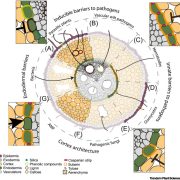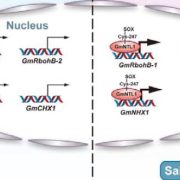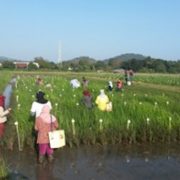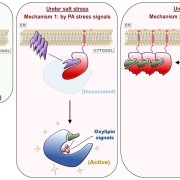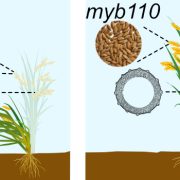Enhancing plants’ capability of P uptake to feed the world
Hu et al. uncover a major regulatory model that can enhance plants’ P uptake from soils.
https://doi.org/10.1093/plcell/koae041
By Dandan Hua, Hengyou Zhangb and Dan Zhanga
a Collaborative Innovation Center of Henan Grain Crops, College of Agronomy, Henan Agricultural University, Zhengzhou, China;
bState Key Laboratory of Black Soils Conservation and Utilization, Key Laboratory of Soybean Molecular Design Breeding, Northeast Institute of Geography and Agroecology, Chinese Academy of Sciences, Harbin, China
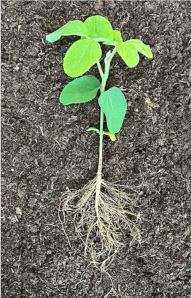 Background: Phosphorus (P), produced from non-renewable phosphate rock, is an essential nutrient for plant growth and development. However, ~40% of the world’s arable land is P deficient. Plants have evolved a series of complex strategies that allow them to adapt to P deficient soils, including phosphate activation, absorption, transport, storage, and reuse. The growth of soybean, a major source of plant-based protein worldwide, requires a large amount of P. Therefore, the availability of P in soils is key to ensuring optimal soybean yields. There is thus an urgent need to develop a genetic solution to improve P uptake and conserve phosphate resources globally.
Background: Phosphorus (P), produced from non-renewable phosphate rock, is an essential nutrient for plant growth and development. However, ~40% of the world’s arable land is P deficient. Plants have evolved a series of complex strategies that allow them to adapt to P deficient soils, including phosphate activation, absorption, transport, storage, and reuse. The growth of soybean, a major source of plant-based protein worldwide, requires a large amount of P. Therefore, the availability of P in soils is key to ensuring optimal soybean yields. There is thus an urgent need to develop a genetic solution to improve P uptake and conserve phosphate resources globally.
Question: Do soybean plants themselves hold the key to developing new high-yield soybean varieties? Can a deeper understanding of the molecular mechanisms underlying phosphate absorption and utilization in soybean help us develop strategies to improve P uptake and use efficiency in this important crop?
Findings: We uncovered a major low P tolerance gene in soybean, GmGDPD2, through genetic methods. Overexpression of this gene significantly promoted root growth and development and increased root uptake of phosphate and yield. By contrast, knocking out this gene inhibited root growth and reduced P absorption, reducing yield. We also identified a GmGDPD2-interacting protein, GA2ox1. GmMyb73 inhibited GmGDPD2 expression by binding to its promoter region. These results allowed us to identify the Myb73-GDPD2-GA2ox1 regulatory module, which helps plants acquire more P from the soil by promoting root growth.
Next steps: We will continue examining the Myb73-GDPD2-GA2ox1 module to dissect the detailed mechanism underlying P efficiency. For example, we found that an acid phosphatase gene GmAPA17 is significantly upregulated in the gdpd2 mutant, which may be an important gene downstream of the module. More genes regulated by GmGDPD2 and their regulatory mechanisms remain to be explored.
Reference:
Dandan Hu, Ruifan Cui, Ke Wang, Yuming Yang, Ruiyang Wang, Hongqing Zhu, Mengshi He, Yukun Fan, Le Wang, Li Wang, Shanshan Chu, Jinyu Zhang, Shanshan Zhang, Yifei Yang, Xuhao Zhai, Haiyan Lv, Dandan Zhang, Jinshe Wang, Fanjiang Kong, Deyue Yu, Hengyou Zhang, Dan Zhang. (2024). The Myb73-GDPD2-GA2ox1 transcriptional regulatory module confers phosphate deficiency tolerance in soybean. https://doi.org/10.1093/plcell/koae041


